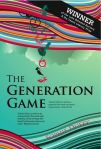
When did you discover your love of books?
I could read before I started school so as long as I can remember I’ve loved books. Mum or Dad read to me every night and once they’d tucked me up, I would hide under the bedclothes with a torch, up late (a notoriously bad sleeper all my life), with a heap of books, looking at the pictures and making up stories until I could make out the text. I loved Ladybird books (which I still have on my bookshelves), Enid Blyton, especially Mr Pink-Whistle and Amelia Jane, and ‘Twinkle’, the comic I got every week as we lived above the newsagent’s run by my parents in Torquay.
When did you decide that you wanted to write your own?
I wrote a lot of stories when I was a child but that fizzled out by the time I reached secondary school when I was more concerned with Wham! and boys. At university I studied English and wrote bad poetry. It wasn’t until my children were small that I went to a creative writing class at the adult education college. By the end of that first lesson I was hooked, and knew I wanted to be a writer. I was 33. It was another ten years before I had my debut novel published.
What can a reader expect from a Sophie Duffy novel?
The reader can expect a nostalgia-fest with a few tears and laughs along the way. They will get a blended, dysfunctional family or group of friends, and a main character trying to negotiate their hazardous journey through the world with all its ups and downs.
Change and facing the difficulties that this presents is a strong theme in your novels. How much of an influence has change in your own life experience driven the empathy you create for your own protagonists?
The one certainty in life is that we will face change. It’s how we adapt to change that marks us as individuals. Sometimes we resist change, sometimes we embrace it. We might make bad decisions. We probably will. And it’s the repercussions of these decisions that echo down the years that I am interested in as a writer.
The award winning The Generation Game (The Yeovil Literary Prize 2006 and Luke Bitmead Bursary 2010) confronts many issues including childhood abandonment and buried secrets. Where did the idea for this acclaimed novel come from?
The idea for ‘The Generation Game’ came from a short story wot I wrote. The idea for the story came from my early childhood when we lived above the newsagent’s (also a sweetshop/tobacconist’s) in the early 70s. Sadly, my father took his own life when I was ten which I suppose counts as abandonment of sorts, so maybe that is why I am drawn to this as a theme. Love and loss go hand in hand but I truly believe that love – often from unexpected places – conquers all. I have bitter sweet memories (if you’ll pardon the pun) from this era, as do most of Generation X who grew up in the golden years of Saturday night television. We have seen several of our childhood icons fall by the wayside in the wake of Operation Yewtree. Thank goodness for Sir Brucie is all I can say.
This Holey Life (runner up of The Harry Bowling Prize 2008) is another successful novel that looks at change and faith with humour, yet balanced reality. What was the greatest challenge this project posed?
I was worried that readers might be put off by a vicar’s wife as a main character but felt encouraged when I saw ‘Rev’ on the television, a sitcom which looks at life in the church and all the eccentric characters that make up a spiritual community. It’s not a ‘Christian’ book as such but a story that embraces life with all its flaws and imperfections.
You are part of the Creative Writing Matters team. How much do you enjoy sharing what you have learned with new writers?
It’s brilliant! I know how much I have learned and continue to learn from other writers. I know that being a writer is a life long process and that I receive more from my students than they get from me. Administering the Exeter Novel Prize and the Exeter Story Prize has also been a revelation. Having read hundreds of thousands of words over the years, I understand more about what makes good writing and good storytelling. I hope this feeds into my own work!

What key piece of advice would you give to an, as yet, unpublished author?
If it’s what you really want, then keep trying. Don’t give up. Enter competitions where your writing will be both read and considered. Keep writing. Read a lot. Listen to feedback, sit on it, and when it rings true, rewrite, edit, submit.
What is next for Sophie?
I have just signed a contract for the next book. All I can say for now is the novel involves two ninety year old ladies, one of whom is the queen. Watch this space…








